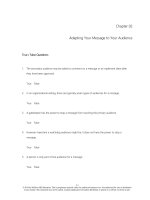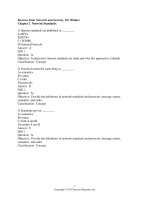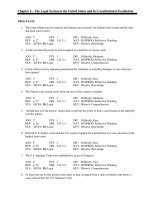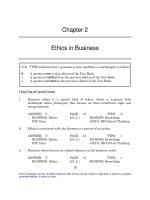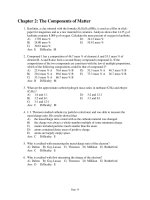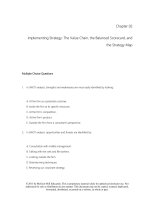Small business management entrepreneurship and beyond 6th edition hatten test bank
Bạn đang xem bản rút gọn của tài liệu. Xem và tải ngay bản đầy đủ của tài liệu tại đây (84.3 KB, 31 trang )
Chapter 2 Small Business Management Entrepreneurship
and Ownership
TRUEFALSE
1. A small business manager and an entrepreneur perform the same functions.
(A) True
(B) False
Answer : (B)
2. Entrepreneurs recognize an opportunity and start a business to take advantage of it.
(A) True
(B) False
Answer : (A)
3. Entrepreneurship and small business management are processes, not isolated incidents.
(A) True
(B) False
Answer : (A)
4. Financial risks, material risks, and psychological risks are all risks faced by the entrepreneur.
(A) True
(B) False
Answer : (A)
5. Mergers, IPOs, and ESOPs are all forms that can be taken in the harvest stage of the startup
process model.
(A) True
(B) False
Answer : (A)
6. A triggering event is a specific event or occurrence that sparks the entrepreneur to proceed from
thinking to doing.
(A) True
(B) False
Answer : (A)
7. In the end, every business will eventually reach the harvest stage.
(A) True
(B) False
Answer : (B)
8. Environmental factors are the traits possessed by the business owner that affect the development
of the small business.
(A) True
(B) False
Answer : (B)
9. Personal characteristics vary as a business evolves from one stage to another.
(A) True
(B) False
Answer : (A)
10. There is only one factor that could be called a triggering event.
(A) True
(B) False
Answer : (B)
11. Personality characteristics are not useful in predicting who will be a successful entrepreneur.
(A) True
(B) False
Answer : (A)
12. The primary reason most people go into business for themselves is to gain the respect of others.
(A) True
(B) False
Answer : (B)
13. Independence and control over their own lives are reasons many people begin small businesses.
(A) True
(B) False
Answer : (A)
14. More than 50 percent of business owners started their own business in order to earn large sums
of money.
(A) True
(B) False
Answer : (B)
15. Individuals who prefer steady pay and a normal nine-to-five work schedule also tend to gravitate
toward self-employment.
(A) True
(B) False
Answer : (B)
16. Income uncertainty is one of the most challenging aspects of starting a new business.
(A) True
(B) False
Answer : (A)
17. The conclusion after more than 30 years of research on personal characteristics is that
successful entrepreneurs cannot be predicted.
(A) True
(B) False
Answer : (A)
18. The typical entrepreneur tends to accept moderate risk only after careful examination.
(A) True
(B) False
Answer : (A)
19. The three most important characteristics that every successful entrepreneur possesses are
perseverance, needed technical skills, and a deep belief in himself/herself.
(A) True
(B) False
Answer : (A)
20. Entrepreneurs tend to have a weaker internal locus of control than do people in general.
(A) True
(B) False
Answer : (B)
21. One's own efforts are the most important factor to a person with a strong locus of control.
(A) True
(B) False
Answer : (A)
22. Over 25 percent of all new business owners have an MBA or other professional degree.
(A) True
(B) False
Answer : (B)
23. Entrepreneurs and small business owners typically have higher education levels than the
general public.
(A) True
(B) False
Answer : (A)
24. The most common form of business in the United States today is the corporation.
(A) True
(B) False
Answer : (B)
25. A sole proprietorship is owned by two or more persons.
(A) True
(B) False
Answer : (B)
26. A major advantage of a sole proprietorship is that the owner has complete control over the
business.
(A) True
(B) False
Answer : (A)
27. The major disadvantage of a sole proprietorship is limited liability.
(A) True
(B) False
Answer : (B)
28. The biggest advantage of partnerships is the pooling of talents and resources.
(A) True
(B) False
Answer : (A)
29. In a partnership, if both partners bring the same qualities to the business, then one of them is
probably not needed.
(A) True
(B) False
Answer : (A)
30. Although the ability to raise capital is better with a partnership than with a proprietorship, a
partnership still cannot usually gather as many resources as a corporation.
(A) True
(B) False
Answer : (A)
31. In a partnership, the partners will be held liable only for their own negligence.
(A) True
(B) False
Answer : (B)
32. If a partner leaves, the partnership is dissolved and the remaining partners can either find a new
partner or terminate the business.
(A) True
(B) False
Answer : (A)
33. One of the most serious problems that can threaten a partnership is managerial conflict.
(A) True
(B) False
Answer : (A)
34. Foresight in writing articles of partnership can solve many partner problems in the future.
(A) True
(B) False
Answer : (A)
35. A closely held corporation publicly trades its shares of stock on a major auction market.
(A) True
(B) False
Answer : (B)
36. A form of business ownership where the business is owned by a limited group of people and the
stock is not traded publicly is called a closely held corporation.
(A) True
(B) False
Answer : (A)
37. Limited liability is the major advantage of forming a business as a corporation.
(A) True
(B) False
Answer : (A)
38. C corporations and S corporations are taxed the same.
(A) True
(B) False
Answer : (B)
39. A document describing a business that is filed with the state in which a business is formed is
referred to as articles of incorporation.
(A) True
(B) False
Answer : (A)
40. C corporations provide individuals with limited-liability protection of a corporation while
allowing the tax advantages of a partnership.
(A) True
(B) False
Answer : (B)
41. LLCs can be an attractive form of ownership for small businesses.
(A) True
(B) False
Answer : (A)
MULTICHOICE
42. According to the opening Vignette, John Goscha can best be described as a/an
(A) Franchiser
(B) Entrepreneur
(C) Corporate business manager
(D) Small business manager
Answer : (B)
43. Rubin's day-to-day job as a business owner involves identifying opportunities for which
marketable ideas exist and assuming the risk to make these ideas happen. Rubin can best be
described as a/an
(A) Innovator
(B) Marketer
(C) Entrepreneur
(D) Small business manager
Answer : (C)
44. Jasper has developed a concept for a start-up company that involves developing a new process
for priming and painting automobile panels. Based on this example, Jasper is focusing on which
entrepreneurial behavior?
(A) Creation
(B) Innovation
(C) Risk assumption
(D) Performance intention
Answer : (B)
45. Which of the following behaviors was not cited as being included in most definitions of an
entrepreneur?
(A) Controlling
(B) Creation
(C) Innovation
(D) Risk assumption
Answer : (A)
46. A small business manager faces which of the following environmental forces?
(A) Finding opportunities
(B) Prompting creativity
(C) Locating an incubator
(D) Hiring and retaining employees
Answer : (D)
47. ____ is the entrepreneurial behavior that involves the expectation of high levels of growth or
profit.
(A) General management
(B) Supply chain
(C) Risk assumption
(D) Performance intention
Answer : (D)
48. Entrepreneurship primarily involves which phase of business?
(A) The startup process
(B) Hiring of key employees
(C) Maintaining a positive cash flow
(D) Building and maintaining a sufficient customer base
Answer : (A)
49. The entrepreneurial process in the startup process model begins with
(A) A visit to the local banker for startup funds
(B) A visit to the local library for more information on the business
(C) A visit to a favorite business professor for advice
(D) An innovative idea that is refined as the idea is thought through
Answer : (D)
50. The entrepreneurship process begins with
(A) An innovative idea
(B) A triggering event
(C) Implementation
(D) Growth
Answer : (A)
51. Sue Pallen is a partner in a cake-decorating company. Her role within the company is to identify
new markets for growth and sustaining the company's long-term financial health by maintaining all
financial records. As such, Sue can best be described as a/an
(A) Entrepreneur
(B) CEO
(C) Nonprofit manager
(D) Small business manager
Answer : (D)
52. The time span for the innovation phase may be
(A) One month or less
(B) One year or more
(C) Several months or even several years
(D) Five years or more
Answer : (C)
53. The phase of implementation in the entrepreneurial process involves all but which of the
following?
(A) Introducing new products
(B) Opening new markets
(C) Industrial reorganization
(D) Developing an advertising campaign
Answer : (D)
54. Which of the following is the key element needed to bring the entrepreneurial idea to reality
during the implementation stage?
(A) Capital/money
(B) Commitment
(C) Management expertise
(D) A college education
Answer : (B)
55. When does the entrepreneurship stage end and the small business management stage begin?
(A) When the maturity stage ends
(B) When the growth stage ends
(C) After the entrepreneurial event ends
(D) When the triggering event ends
Answer : (C)
56. Which stage of the startup process is characterized by relative certainty that the business will
survive?
(A) Growth
(B) Maturity
(C) Harvest
(D) Implementation
Answer : (B)
57. The stage in the startup process model in which the small business owner removes
himself/herself from the business is which of the following?
(A) Growth
(B) Maturity
(C) Implementation
(D) Harvest
Answer : (D)
58. In the growth stage of the startup process model, what is the primary goal of the small business?
(A) Regulations
(B) Employees
(C) Vendors
(D) Reaching critical mass (survival)
Answer : (D)
59. Forces that occur outside of the business that affect the business and its owner are referred to
as
(A) Financial factors
(B) Controlled factors
(C) Environmental factors
(D) Internal factors
Answer : (C)
60. In the triggering event and the implementation stages of the startup process model, which of the
following environmental factors will affect the small business?
(A) Role models
(B) Suppliers
(C) Bankers
(D) Competition
Answer : (D)
61. An entrepreneur faces which of the following environmental forces?
(A) Hiring and retaining employees
(B) Dealing with vendors and suppliers
(C) Fighting government regulations
(D) Identifying product opportunities
Answer : (D)
62. In the ____ stage of the business management process, attention is placed on team building,
setting strategies, and creating a structure and culture of the business.
(A) Harvest
(B) Growth
(C) Maturity
(D) Innovation
Answer : (B)
63. In the triggering event stage of the startup process model (Figure 2.3), which of the following
personal characteristics are needed by the small business owner?
(A) Leadership
(B) Vision
(C) Commitment
(D) Boredom
Answer : (C)
64. In the innovation and triggering event stages of the startup process model (see Figure 2.3),
which of the following personal characteristics are needed by the small business owner?
(A) Better opportunity
(B) Planning
(C) Commitment
(D) Risk taking
Answer : (D)
65. In the growth stage of the startup process model (Figure 2.3), which of the following
organizational characteristics is needed?
(A) Strategy
(B) Marketing
(C) IPO
(D) Operation management
Answer : (A)
66. About half of all business owners choose to go into business for themselves because they
(A) Want to earn lots of money
(B) Like the challenge
(C) Want to avoid hard work
(D) Want to fulfill others' expectations
Answer : (B)
67. The primary reason most people start their own business is to
(A) Build for their family
(B) Earn large sums of money
(C) Use their skills/abilities
(D) Live where they like
Answer : (C)
68. Some of the risks assumed through self-employment include all of the following except
(A) Income uncertainty
(B) Long work hours
(C) Personal liability
(D) A change in the owner's personality
Answer : (D)
69. Which of the following is not prerequisite for becoming a successful entrepreneur?
(A) Passion
(B) Determination
(C) Knowledge
(D) Education
Answer : (D)
70. In the Reality Check "Small Biz on Campus," what did Whitney Williams begin selling while still
in college?
(A) Unique-flavored chewing gum
(B) A new water-skiing product
(C) Refurbished cell phones
(D) Custom jewelry
Answer : (D)
71. At Wingate University, a product that wirelessly connects to a smartphone and app to test blood
alcohol levels was developed by
(A) Faculty
(B) Students
(C) Research specialists
(D) Campus police
Answer : (B)
72. The personal quality linked to entrepreneurship in which people are motivated to excel and
choose situations where success is likely is known as
(A) Locus of control
(B) Need to achieve
(C) Need to succeed
(D) High performance goals
Answer : (B)
73. The ability to control one's own fate is known as
(A) Locus of control
(B) Self-determination
(C) Perseverance
(D) Need to achieve
Answer : (A)
74. The ability to see, conceive, and create new and unique products, services, and processes is
known as
(A) Innovation
(B) Risk taking
(C) Product development
(D) Locus of control
Answer : (A)
75. A characteristic of entrepreneurial personality that leads one to avoid goals that would be
extremely difficult to achieve or goals with success almost guaranteed is called
(A) Internal locus of control
(B) A high desire for risk
(C) Flexibility
(D) A high need to achieve
Answer : (D)
76. After spending 15 years working in the restaurant industry, Alex has decided to open a
restaurant of his own. His 15 years of experience will allow him to capitalize on which of the
following?
(A) Passion
(B) Determination
(C) Trustworthiness
(D) Knowledge
Answer : (D)
77. In terms of education level of new business owners, the most common educational degree level
is the
(A) Bachelor degree level
(B) MBA level
(C) PhD level
(D) Associate degree level
Answer : (A)
78. The one overriding characteristic needed to be a successful small business owner is which of the
following?
(A) Confidence
(B) Energy
(C) Vision for the future
(D) Incredible tenacity
Answer : (D)
79. Which percentage of new business owners have had at least some college education?
(A) 25 percent
(B) 50 percent
(C) 60 percent
(D) 80 percent
Answer : (C)
80. Which two areas of coursework are the fastest growing subjects in business schools?
(A) Management and Marketing
(B) Entrepreneurship and Small Business Management
(C) Operation Management and Finance
(D) Management and Finance
Answer : (B)
81. One-day to one-year programs offered through college extension departments that are tailored
to entrepreneurs and small business owners are referred to as
(A) Small-business counseling programs
(B) Entrepreneurial degree programs
(C) Corporate grind programs
(D) Executive education programs
Answer : (D)
82. Which of the following is more important in the future development of a small business owner
than the formal education received in school?
(A) Financial backing
(B) Management expertise
(C) Lifelong learning
(D) Technical skills
Answer : (C)
83. The three forms of business ownership include all but which of the following?
(A) Sole proprietorships
(B) Partnerships
(C) Corporations
(D) Joint ventures
Answer : (D)
84. Which of the following is the most common form of business ownership?
(A) Sole proprietorships
(B) Partnerships
(C) Corporations
(D) Joint ventures
Answer : (A)
85. Which of the following forms of business ownership brings in the most business-generated
revenue?
(A) Sole proprietorships
(B) Partnerships
(C) Corporations
(D) Acquisitions
Answer : (C)
86. The trends for small businesses in the United States from 1980 to 2003 show the greatest
increase in the number of
(A) Partnerships
(B) Public corporations
(C) Very small businesses
(D) Private corporations
Answer : (C)
87. Les, a certified public accountant, is looking to open a new accounting firm. Previously, Les was
part-owner of a firm where he fought regularly with other co-owners about management decisions. If
he wants to avoid such conflicts and promote independence, which of these should he choose?
(A) Sole proprietorship
(B) Partnership
(C) Corporation
(D) A public company
Answer : (A)
88. Which form of business ownership grew most rapidly from 1980 to 2006 as evidenced by the
number of business tax returns filed?
(A) Sole proprietorships
(B) Partnerships
(C) Corporations
(D) Mergers
Answer : (A)
89. Which form of business ownership is the single best form in which to organize a small business?
(A) Sole proprietorships
(B) Partnerships
(C) Corporations
(D) There is no single best form.
Answer : (D)
90. The following are advantages of which form of business ownership: complete control over the
business, few legal requirements and restrictions, and taxed as a single entity?
(A) Sole proprietorship
(B) Partnership
(C) Corporation
(D) Joint venture
Answer : (A)
91. Which form of business organization is easiest to open and easiest to close?
(A) Partnership
(B) Sole proprietorship
(C) Corporation
(D) A public company
Answer : (B)
92. The tax advantage for sole proprietorships does not last forever. The businessperson must make
money in order to be considered a business. Money must be made for how many years in order to be
considered a business and not a hobby by the IRS?
(A) Two out of five years
(B) Three out of five years
(C) Four out of five years
(D) Four out of six years
Answer : (B)
93. The single biggest disadvantage of sole proprietorships is which of the following?
(A) Limited resources
(B) Limited skills
(C) Unlimited liability
(D) Double taxation
Answer : (C)
94. Which disadvantage of sole proprietorships centers around the fact that capital is difficult to
raise?
(A) Limited resources
(B) Limited skills
(C) Unlimited liability
(D) Lack of continuity
Answer : (A)
95. Which of the following is created to complete a specified purpose and is limited in duration?
(A) Sole proprietorship
(B) Joint Venture
(C) C Corporation
(D) S Corporation
Answer : (B)
96. The following are advantages of which form of business ownership: pooled talent, pooled
resources, easy to form, tax advantages?
(A) Sole proprietorships
(B) Partnerships
(C) Corporations
(D) Acquisitions
Answer : (B)
97. A business structure in which the business owners share the management and all of the risk of a
business is called a
(A) Sole proprietorship
(B) General partnership
(C) Limited partnership
(D) Corporation
Answer : (B)
98. The following are disadvantages of which form of business ownership: unlimited liability,
management conflict potential, and less independence?
(A) Sole proprietorships
(B) Partnerships
(C) Corporations
(D) Mergers
Answer : (B)
99. Alice is co-owner of a company where she has unlimited liability. However, there are three
additional co-owners within the same company that have limited liability. This company can best be
described as a/an
(A) Unlimited partnership
(B) Limited partnership
(C) Uniform partnership
(D) Limited liability company
Answer : (B)
100. Without a written agreement, a partnership operates according to the rules of the states under
the
(A) Uniform Partnership Act
(B) State Regulated Partnership Act
(C) Federal Partnership Act
(D) Small Business Administration
Answer : (A)
101. In a limited partnership, at least one partner
(A) Has unlimited liability
(B) Has limited liability
(C) Has raised 50 percent more capital than the other partners
(D) Has given up any tax advantages
Answer : (B)
102. The "right of first refusal" refers to which of the following?
(A) Partners may refuse to let one of the partners leave the business.
(B) Partners may allow one partner to have only limited liability.
(C) Partners may have first chance at buying the selling partner's shares in the business.
(D) Partners may refuse to pay out the profits of the business and instead reinvest the money back
into the business.
Answer : (C)
103. A business structure in which one or more of the owners may be granted limited liability as
long as one partner is designated a general partner is called a
(A) General partnership
(B) Fragmented partnership
(C) Limited partnership
(D) Segmented partnership
Answer : (C)
104. If the partners in a partnership have not written a legal agreement, which act helps to settle
any problems that may arise?
(A) SBA
(B) SEC
(C) UPA
(D) FTC
Answer : (C)
105. A contract between partners of a business that defines obligations and responsibilities of the
business owners is called the
(A) UPA
(B) Incorporation of the Partnership
(C) Article of Partnership
(D) Partnership Contract
Answer : (C)
106. Corporations that sell shares of stock to the public and are listed on the stock exchange are
referred to as
(A) Divested corporations
(B) Entrepreneurial corporations
(C) Closely held corporations
(D) Public corporations
Answer : (D)
107. A partnership that is created to complete a specified purpose and is limited in duration is
called a
(A) General partnership
(B) Limited partnership
(C) Corporation
(D) Joint venture
Answer : (D)
108. Which form of business ownership is the most complicated to form?
(A) Sole proprietorships
(B) Partnerships
(C) Corporations
(D) Subsidiaries
Answer : (C)
109. As far as the courts are concerned, a corporation has all but which of the following rights?
(A) The right to sue
(B) The right to own property
(C) The right to engage in transactions
(D) The right of first refusal
Answer : (D)
110. Sylvia is looking to start her own sporting goods manufacturing company, but the venture will
require a great deal of start-up investment. Which of these should she choose to ensure adequate
financing?
(A) Partnership
(B) Sole proprietorship
(C) Corporation
(D) Small independent business
Answer : (C)
111. Which of the following forms of business ownership has the following advantages: limited
liability, increased access to resources, and easy transfer of ownership?
(A) Sole proprietorship
(B) Partnership
(C) Corporation
(D) Joint venture
Answer : (C)
112. Which of the following forms of business ownership has the following disadvantages: expensive
to start, complex to maintain, and double taxation?
(A) Sole proprietorship
(B) Partnership
(C) Corporation
(D) Closely held corporation
Answer : (C)
113. The legal and administrative costs are one of the major disadvantages of which form of
business ownership?
(A) Sole proprietorships
(B) Partnerships
(C) Corporations
(D) General partnerships
Answer : (C)

